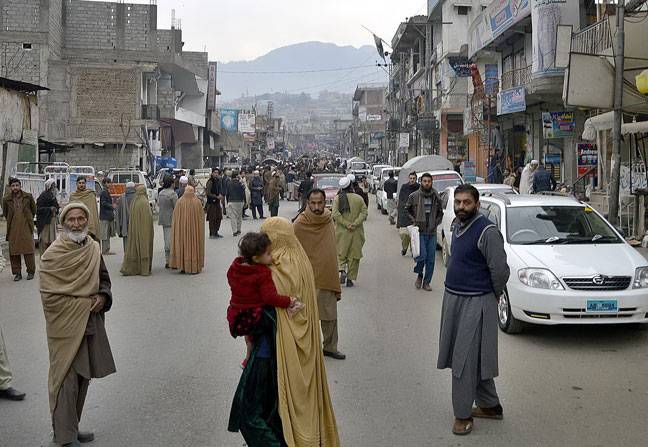Islamabad/Peshawar/Quetta - A minor girl was killed in Balochistan and at least 15 others injured in a 6.1-magnitude earthquake, which sent ripples of fear across Pakistan on Wednesday.
In Swat Valley, a visitor in a local hotel passed away after suffering a heart attack due to fear of the jolts.
The tremors from the quake, which originated in Afghanistan part of Hindu Kush mountain range, were felt as far as Kashmir and Indian states of Punjab and Haryana.
According to the United States Geological Survey (USGS), the epicentre of the earthquake was 35 kilometres south of Jarm in Afghanistan. The depth of the quake was estimated to be 191.2kms. The National Disaster Management Authority (NDMA) said it did not expect serious losses in the quake; however, teams were dispatched to Balochistan and KP to assess reports of scattered damage.
Officials said that Lasbela and and Uthal areas of Balochistan were most affected where walls of several houses collapsed, injuring a total of 11 people.
A two and a half years girl, Tehmina, died when the roof of her house collapsed, in Bela Union Council of Lasbela district. Two of her sisters also suffered injuries.
“The injured have been rushed to a nearby hospital for medical treatment. An emergency has been declared in all hospitals”, Lasbela Deputy Commissioner Shabir Ahmed Mengal said.
In Peshawar, Lahore and Parachinar, panicked locals ran out of their homes and came out onto the streets as the quake’s tremors were felt.
Four girls received minor injuries at a primary girls school in Peshawar during a rush to evacuate the premises, Rescue 1122 sources said. The girls were rushed to Lady Reading Hospital for treatment.
In Landi Arbab, a village near Peshawar, two children were injured as they were running out of their school in a panic, Peshawar District Nazim Muhammad Asim Khan said. A control room has been established and emergency services have been activated by the Chitral deputy commissioner to aid those affected by the quake.
In Islamabad, the windows and doors of the Supreme Court shook during the quake.
Chief Justice of Pakistan Mian Saqib Nisar, who was hearing a case at the time, told observers and lawyers present in the courtroom to remain seated as the “earthquake would subside after the initial shocks”.
Cellphone signals were temporarily disrupted in Islamabad and Peshawar due to the quake.
Afghanistan is frequently hit by earthquakes, especially in the Hindu Kush mountain range, which lies near the junction of the Eurasian and Indian tectonic plates.
Jarm, the origin point of Wednesday’s quake, was hit by a devastating 7.5 magnitude quake in October 2015, triggering landslides and flattening buildings, killing more than 380 people across the region.
The bulk of the recorded casualties were in Pakistan, where 248 people were killed, including 202 in Khyber Pakhtunkhwa, and more than 1,600 injured.
Aid agencies have stressed the need for greater disaster preparedness in the war-torn Afghanistan, which remains extremely susceptible to recurring natural disasters such as floods, earthquakes and landslides.
But deteriorating security has seen international NGOs such as the Red Cross and Save the Children downgrade their operations across the country, making it even more difficult to deliver crucial help to its most vulnerable citizens.
2018 could be a year of deadly quakes
Scientists have warned of a significant increase in the occurrence of potentially deadly earthquakes in 2018.
The assessment was made on the basis of the Earth’s movement data which shows a significant uptick in earthquakes after a certain period of slowdown in the Earth’s rotation.
According to the report, geophysicists are able to measure the rotational speed of Earth with extreme precision, calculating slight variations on the order of milliseconds.
Geophysicists believe Earth’s rotation is cyclical, slowing down by a few milliseconds per day then speeding up again, a geologist Trevor Nace said in the report.
Researchers found that roughly after every 32 years there was an uptick in the number of significant earthquakes worldwide.
A team of researchers found this conclusion after analysing every earthquake which occurred since 1900 at a magnitude above 7.0.
The research concluded that after almost every 30 years, Earth experiences a slowdown in its rotation.
The slowdown lasts for five years, with the last year triggering an increase in earthquakes globally.
“In these periods, there were between 25 and 30 intense earthquakes a year,” Bilham, a researcher, said last year. “The rest of the time the average figure was around 15 major earthquakes a year,” he added.
Based on the calculations, 2017 was the fourth consecutive year that witnessed a slowdown in Earth’s rotation. So scientists are expecting more earthquakes in 2018.
The correlation between Earth’s rotation and earthquakes was recently highlighted at the annual meeting of the Geological Society of America.








